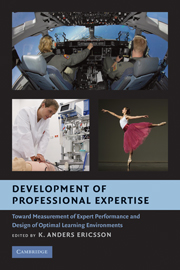 Development of Professional Expertise
Development of Professional Expertise Book contents
- Frontmatter
- Contents
- List of Figures
- List of Tables
- List of Contributors
- 1 The Measurement and Development of Professional Performance: An Introduction to the Topic and a Background to the Design and Origin of This Book
- SECTION 1 CHALLENGES IN PAST AND CONTEMPORARY EFFORTS TO MEASURE AND TRAIN THE OBJECTIVE PERFORMANCE OF PROFESSIONALS
- SECTION 2 PAST AND CONTEMPORARY EFFORTS TO DESIGN INSTRUCTION, TRAIN, AND MAINTAIN PROFESSIONAL PERFORMANCE
- 6 Research on Past and Current Training in Professional Domains: The Emerging Need for a Paradigm Shift
- 7 Designing Training for Professionals Based on Subject Matter Experts and Cognitive Task Analysis
- 8 How to Help Professionals Maintain and Improve Their Knowledge and Skills: Triangulating Best Practices in Medicine
- 9 Advances in Specifying What Is to Be Learned: Reflections on the Themes in Chapters 6–8
- SECTION 3 THE ASSESSMENT AND TRAINING OF SKILLED AND EXPERT PERFORMERS IN THE MILITARY
- SECTION 4 THE DEVELOPMENT OF EXPERTISE AND EXPERT PERFORMANCE
- Name Index
- Subject Index
- References
9 - Advances in Specifying What Is to Be Learned: Reflections on the Themes in Chapters 6–8
Published online by Cambridge University Press: 04 August 2010
- Frontmatter
- Contents
- List of Figures
- List of Tables
- List of Contributors
- 1 The Measurement and Development of Professional Performance: An Introduction to the Topic and a Background to the Design and Origin of This Book
- SECTION 1 CHALLENGES IN PAST AND CONTEMPORARY EFFORTS TO MEASURE AND TRAIN THE OBJECTIVE PERFORMANCE OF PROFESSIONALS
- SECTION 2 PAST AND CONTEMPORARY EFFORTS TO DESIGN INSTRUCTION, TRAIN, AND MAINTAIN PROFESSIONAL PERFORMANCE
- 6 Research on Past and Current Training in Professional Domains: The Emerging Need for a Paradigm Shift
- 7 Designing Training for Professionals Based on Subject Matter Experts and Cognitive Task Analysis
- 8 How to Help Professionals Maintain and Improve Their Knowledge and Skills: Triangulating Best Practices in Medicine
- 9 Advances in Specifying What Is to Be Learned: Reflections on the Themes in Chapters 6–8
- SECTION 3 THE ASSESSMENT AND TRAINING OF SKILLED AND EXPERT PERFORMERS IN THE MILITARY
- SECTION 4 THE DEVELOPMENT OF EXPERTISE AND EXPERT PERFORMANCE
- Name Index
- Subject Index
- References
Summary
INTRODUCTION
Advances in Instructional Design
If you want to be successful in designing effective instruction, you need to begin with a clear specification of what is to be learned. This is a central premise underlying various instructional-design theories since their inception (Reigeluth, 1983, 1999; Reiser & Dempsey, 2007). The three chapters in this section provide a useful description of advances in the field of instructional design, focusing on techniques for specifying what is to be learned. In this review, after a brief analysis of the types of knowledge, I examine four phases in the evolution of instructional-design approaches. As summarized in Table 9.1, these phases involve different ways of characterizing what is to be learned – compartmentalized behaviors, compartmentalized knowledge, integrated knowledge, and individualized knowledge.
APPLYING THE SCIENCE OF INSTRUCTION
Learning is a change in the learner's knowledge due to experience (Mayer, 2001). Instruction is the systematic manipulation of the learner's experience in order to foster learning (Mayer, 2003). In short, learning involves a change in the learner's knowledge and the goal of instruction is to foster a change in the learner's knowledge. However, you can only infer a change in the learner's knowledge indirectly by observing a change in the learner's behavior, such as changes in the learner's performance on a specified task.
- Type
- Chapter
- Information
- Development of Professional ExpertiseToward Measurement of Expert Performance and Design of Optimal Learning Environments, pp. 203 - 212Publisher: Cambridge University PressPrint publication year: 2009
References
- 3
- Cited by
